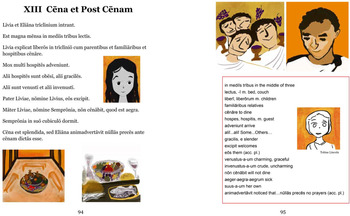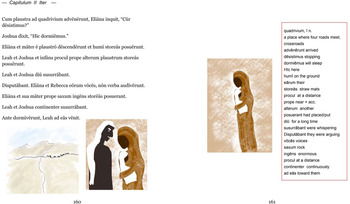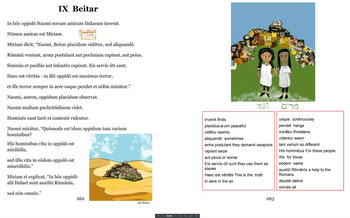
Figure 1. Cover: Provincia Iudaea
Provincia Iudaea is a supplementary reader for beginning and intermediate Latin students. It includes three stories set in first-century Judaea. The stories explain the confrontation between Romans and Jews at this time. The first story unfolds through the eyes of the main character, a young Jewish girl named Eliana. After the destruction of the Second Temple in 70 CE, Eliana and her mother escape to Masada. Many years later, 132 CE, another character, Naomi, completes the narrative about the final struggle between Romans and Jews during the Bar Kochba Revolt. The book concludes with Hadrian's proclamations. Illustrations abound in this reader, giving students an anchor for understanding the narrative. Vocabulary is provided on facing pages so that students can read without the burden of looking up words. Some words appear in the dictionary entry format, whereas others are simply glossed. The reason for this is not to burden students with grammatical details

Figure 2. Extract from Eliana, pages 94–95
The dictionary words are words which students should know or learn. The stories are engaging, informative, and (I hope) thought-provoking, and are designed to arouse students' interest in history, leading to class discussions about customs, religion, language and life. The stories are written in Latin and include some Hebrew and Greek, thus reflecting multi-cultural first-century Judaea.

Figure 3. Extract from Masada, pages 160–161
This project began three years ago. I had attended several Comprehensible Input (CI) workshops and liked the idea of incorporating CI ideas into my lessons. It was lots of fun, but it stopped there. Then I found that there were many new, good, Latin paperback readers for students to enjoy. These were fun and instructional, but not meaningful in the way that I think grabs students’ attention and inspires them to know more. It was then that I came up with an idea for my book. I wanted students to read something that I hoped would prompt real-world discussions. I wanted students who didn't celebrate Christmas and sing Latin Christmas Carols by heart to feel more included and have the opportunity to share their cultural background with their peers. We don't have much diversity in Boulder, Colorado, where I live, but I was and am keenly aware that there is a need to hear more voices. Students sampled my work over the course of three years. The story changed again and again as I made decisions about what was going to happen and why. In the end I completed a narrative that leant itself to relevant modern discussions about different kinds of people living together.

Figure 4. Extract from Aelia Capitolina, pages 262–263
I did most of the illustrations myself but featured students’ work as well. I thought that seeing Romans from a different perspective would be of great value. What was it like to live under Roman rule when your culture is not their culture? I finished writing my book and with great help from excellent editors, it was ready to go. Yes, Provincia Iudaea is a fictional story set in the first century CE. It is not meant to be a history book. The focus is on young Jewish girls and their experiences. Over the course of my 30-year plus Latin teaching career, I have learned that keeping up with the times is mere survival, but embracing changing times, questioning your methods, experimenting with new ideas, failing sometimes, and learning from mistakes, not only hones your skills but also keeps customers coming. In this 21st century, Latin has not lost its value because it is a powerfully rich language; however, that fact is not enough to keep Latin alive. I believe that Latin has survived and flourished because Latin teachers are willing to grow and change. For me, teaching has always been a dance. Teachers and students are partners. Small adjustments in my teaching methods have kept students on the dance floor. How discouraging it would be to dance with a know-it-all teacher, who delights in him/herself and steps on everyone's toes, except for those of the very elite, few, and naturally talented students. I learned early on to make Latin accessible to all. My book, Provincia Iudaea, is an example of that dance.






